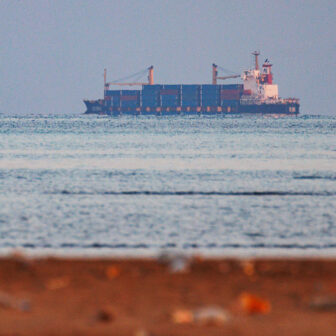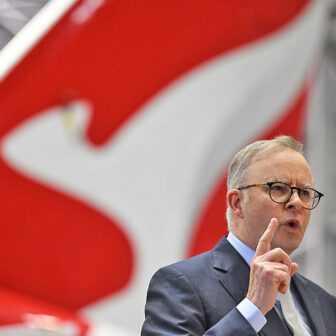THE ARRIVALS hall was small and airless, filled with people pushing, shouting, cursing and sweating as they jostled towards passport control. A single bag scanner had been set up to deal not only with hand luggage but also with the overloaded suitcases, brightly coloured plastic sacks and various other odd-shaped packages that passengers had checked in before departure. Those waiting, or rather hoping, to collect their belongings included people who had landed several days before but whose luggage had not. Despite the heat and crush no water or other refreshments were available. It was, in short, every traveller’s nightmare vision of a Third World airport, minus only the gun-toting customs official trying to extract a bribe.
The setting was Juba, the capital of South Sudan, which, three days after my arrival, was to become the world’s newest country. The South’s government, which is building a new airport alongside the existing one, could offer reasonable excuses for the state of the current facility. The Republic of South Sudan, as it is now known, is one of the world’s poorest and least-developed nations, thanks largely to nearly forty years of conflict since Sudan achieved independence in 1955. A flashy airport was not – and should not have been – the first priority when the last war with the Arab-dominated government in Khartoum ended in 2005.
And besides, who could have predicted the volume of air traffic circling into South Sudan today? When I first came to Juba six years ago there were no commercial flights, so I flew in on a cargo plane chartered by South Sudan’s rebel army. (There was only one hotel in the city, which had been held by the northern army during the war, and barely any paved road.) On the way out of Juba the cargo plane was full, and after sitting on the tarmac – literally – for several hours, I ended up catching a lift home in a very smart corporate jet hired by some British oil executives, among them Phil Edmonds, the former English cricketer.
Later, it was possible to fly in from Kenya on a scheduled flight twice a week. And today three commercial airlines fly from Nairobi to Juba each day, two of them twice daily, including the national carrier Kenya Airways and a budget airline, Fly540, with which I flew this time. There are also direct flights from Khartoum to the north, Ethiopia to the east and Uganda to the south. Indeed, the arrival within an hour of planes from each of these places was one of the reasons that the baggage area at the airport was so chaotic.
Presidents and prime ministers travel in a different style, of course, and don’t have to worry about lost luggage. The birth of a new nation doesn’t happen every day, and numerous African leaders – as well as senior European and US legislators – flew in on their private jets for the independence celebrations, forcing the closure of the airport to commercial traffic for two days around the main event. East Africa, which felt the effect of South Sudan’s wars as refugees streamed over various borders, was well represented, with the Kenyan, Ugandan, Tanzanian, Rwandan and Ethiopian leaders all arriving at the John Garang Mausoleum in Juba in convoys of luxury, bullet-proof vehicles for the official ceremony on Saturday 9 July. “VVIP” guests from West Africa included Goodluck Jonathan of Nigeria and Teodoro Obiang from Equatorial Guinea, while South Africa’s Jacob Zuma and Rupiah Banda of Zambia were among those who flew in from further south with the obligatory retinues of advisers and bodyguards. Then, shortly after noon, the Republic of South Sudan was born, and within hours the foreign leaders were back at the airport, boarding their private planes.
If they’d wanted to, the leaders arriving from beyond East Africa could well have returned home on commercial airlines with not much less convenience – something that was inconceivable even just a few years ago when a cross-continent trip promised to be an ordeal, and a very long one at that. One of the first elections I covered in Africa was in Liberia, another country emerging from devastating conflict, in 2005. Those were days of fatter newspaper travel budgets – an era when trips were normally approved or not by a foreign editor based on the merits of the story rather than on the cost of getting there and travelling around. Getting to Liberia from Nairobi proved difficult. There were no direct flights to Monrovia, Liberia’s capital, and the travel department at the Times of London, where I was then working, could find no connecting flights within Africa either. Instead, I flew to Belgium, and from there to Monrovia, a journey that took about two days with the stopover included, if I recall correctly. My expense claim was not insignificant.
This was not a Liberia-specific problem; the destination could have been any one of several capitals in West Africa. Back then, travelling across Africa by plane invariably meant first leaving Africa.
Six years on, the situation has changed drastically. Kenya Airways, part-owned by the Dutch airline KLM, now flies to Monrovia three times a week. In West and Central Africa it flies to Ivory Coast, Benin, Nigeria, Senegal, Ghana, Cameroon, Mali, Equatorial Guinea, Sierra Leone, Chad, the Central African Republic and Gabon. Earlier this month, it commenced flights to Ouagadougou, the capital of Burkina Faso. East and Southern Africa are even better served. Even though North Africa is still poorly connected – to get to Tunisia recently my best option was via Doha, in Qatar – Kenya Airways now flies to thirty-five African capitals or main cities out of fifty-four. At the pace new routes are being added, the company’s claim that it intends to serve every African capital by 2013 doesn’t seem too far-fetched, especially if Mogadishu in war-torn Somalia is left off the list.
Kenya Airways has the widest network on the continent, but it’s not alone in spreading its wings. Ethiopian Airlines, a respected international carrier, now serves around half of Africa’s capitals or major cities. And South African Airways is not far behind. In Sub-Saharan Africa, only West Africa lacks a carrier with links across the continent, and surely that will change soon. A number of smaller regional airlines are also expanding quickly, serving domestic and other short-haul destinations. South Africa has several budget airlines that have drastically reduced the cost of flying. In Kenya, Fly540 offers internet booking and flies to numerous cities and towns around the nation daily, as well as to neighbouring countries. With cut-price fares aimed mainly at local middle-class travellers, it has already carved out a healthy niche for itself in the market.
Another Kenya-based airline, Jetlink, serves a similar clientele, and has opened up new routes that the bigger players have overlooked, including to places like the Democratic Republic of the Congo. Journalists, aid workers and businesspeople trying to reach eastern DRC used to have fly to Rwanda and then make a journey of three or four hours by taxi to the border. I once tried a different, more direct route, flying from Nairobi with a conservationist in a tiny two-seater plane he’d built from a kit. We bought fuel for the flight early one morning at a petrol station near Nairobi’s Wilson Airport, and then set off on the five-hour journey. Initially, as we flew low over the Rift Valley, it was spectacular. Later on it became deeply uncomfortable after I was unable to keep my lunch down as we circled over a lake and the bottom of the conservationist’s airsick bag gave way.
Today you can fly with Jetlink directly to Goma, the main city in east DRC, a journey that is quicker, safer and easier on the stomach. That’s not to imply that flying within the DRC using local airlines is safe. Indeed, the country has one of the worst safety records in the world. Some of its airports are in terrible shape, as are many of the planes, which saw better days when they were still in the air above the then Soviet Union. Every few months there seems to be another accident with dozens of passengers killed. It’s a record that still tarnishes the entire airline industry across the continent in the eyes of some. Indeed, a few years ago when my newspaper needed to fly me to London the person booking the ticket got into a flap when British Airways flights came up full. Feeling guilty about the nightmare journey – or even the crash – I was about to endure she booked me a business-class ticket on Kenya Airways. Sadly, this precautionary move on the part of my employers has not been repeated, and I’ve never turned left when boarding a plane again.
The benefits of the rapid opening of African skies are many. Increasing numbers of middle-class Africans can now afford to fly – not just within the continent, but onwards to faraway destinations such as China, where thousands of Africans land each week to buy cheap goods for resale at home. Businesspeople on one side of Africa can now get to major cities on the other the very same day; leave Nairobi on Kenya Airways at 9.30 am and you will arrive in Liberia at 3 pm on the same day. A vast and diverse continent has become a much smaller place.
This is surely a boon for investment in places like the Republic of South Sudan. Before the country became independent, the global drinks giant SABMiller was one of the few multinationals willing to take a punt on its future, spending many millions of dollars building a large brewery on the edge of town. Now that Sudan’s split has gone ahead peacefully, what would stop other companies having a look? Certainly not logistics or travel fatigue, since you could leave a European capital in the evening and be in Juba before noon the following day.
Getting around the new country is more tricky. Distances are vast, and the road network poor. Currently the United Nations operates most of the internal flights. But a few commercial carriers have already started operating, and the market can only grow. And the new airport, hidden behind a giant poster of the Southern president, Salva Kiir, during the independence celebrations, will make things more comfortable. Though as I sat in the old airport waiting for my flight home it suddenly didn’t seem so bad. The Wi-Fi hotspot and cold Coke, luxuries absent while I was waiting for my luggage on the way in, might have had something to do with it. •
Come fly with me
Broadcaster Robyn Williams looks at how aviation can deal with the carbon challenge




